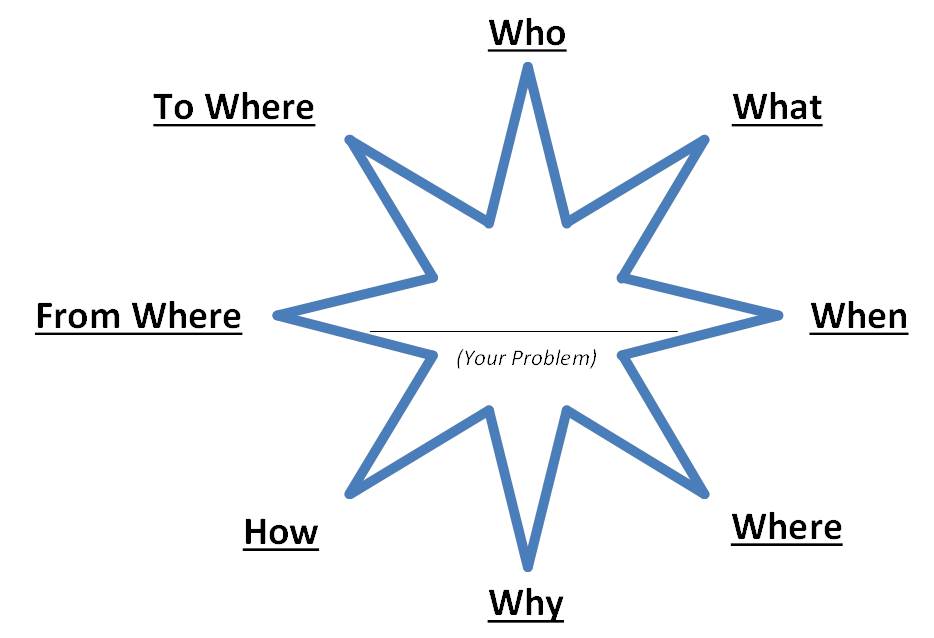Interrogatory Dimensions
Friday, February 28, 2014

Finding answers to your questions is an important part of finding solutions to your problems.
In today's search engine driven society we have unprecedented abilities to search for our answers. However, the step that precedes this searching activity, asking questions, is not given as much attention.
In this blog, I'm going to discuss the ideas, methods, and strategies you can use to formulate and manage your questioning activities.
Our Curiosity
Since the dawn of human development, curiosity has been a hallmark of our species. One only has look into the eyes of a baby to see this. The desire to understand the world around us is hard wired into each human being.
The Language of Questions
Our language is structured to describe different kinds of questions. An example of this is the age-old journalist's list of: who, what, when, where, why, and how. These are referred to as interrogatory words.
Interrogatory words have evolved over time as our language has developed. Unfortunately, sometimes these changes have tended to dumb down the language. Sometimes the current popular usages of our language aren't the most precise.

I found an example of this in the history of interrogatory words. In my early problem solving activities, I kept running into the same issue. The interrogatory word when didn't adequately define some aspects of the time continuum.
'When' was fine for defining data that was closely related to the present state but wasn't very good at defining my root causes or outcomes. This kept happening to me, so I decided to see if I could find a solution to this 'problem'.
When I researched the root words related to questioning, I found two no longer used archaic words, whence and whither.
These words defined just what I was looking but I thought these archaic usages might not work so well for other people. So, I needed to find out if there were any modern usages of whence and whither. It turned that the best modern usages I could find for whence and whither were from where and to where.
Interrogatory Words
Here's my list of interrogatory words:
• Who: People, Groups, Human Aspects
• What: Things, Events, Circumstances
• When: Time, Sequences
• Where: Places, Locations
• Why: Reasons
• How: Methods, Manners, Ways
• From Where: Origins, Sources, Root Causes
• To Where: Destinations, Outcomes, Goals
Key Questions

Asking key questions is one of the most important techniques you can use to explore the different dimensions of your problem. It just makes sense that finding the right questions will give you a better understanding of your problem and get you closer to the answers that will eventually solve your problem. As you go through the problem-solving process keep track of your key questions. To help you get started, I've developed several lists of generic questions: Who, What, When, Where, Why, How, From Where, To Where, and the Phoenix Checklist. Review the lists of generic questions and pick out the ones that you consider to be key questions for your situation. Of course, the questions you think of on your own could be the best questions of all.
Starbursting Tool
Here's a diagram of my Starbursting tool:

PRINTABLE: PDF version of Starbursting.pdf (Click link to download PDF version).
Completeness of Questioning

To make sure your analysis is complete, you should always ask each one of the eight types of interrogatory questions for each major category of your problem and for each possible solution. In-other-words, this is one of the methods you can use to make sure your analysis is complete.
Interrogatory Questions vs. Interrogatory Dimensions

Interrogatory dimensions are different from interrogatory questions, in that they also include the answers to those questions. Aligning the types of questions (with their corresponding answers) will help you align your thinking.
This is also practical because now you can describe all of your objective data with an interrogatory dimension. This adds an important structural element to your analysis.
Mirroring

Understanding the questions that surround your problem is certainly important to your analysis. But you also need to understand the questions surrounding the other half of the problem solving equation - the questions about your solutions.
There are certain elements in the structure of your problem that will be shared by your solution. One of those structural elements is interrogatory dimensions. As you go thru the problem solving process, keep in mind that there's a 'mirroring effect' between the structure of your problem and the structure of your solution.
The Root of Your Question
As discussed above, interrogatory dimensions describe your data by the root of the underlying question. So, how can this help you?
By using this question-centric focus to you analysis, you can use questioning techniques similar to the age-old 'journalist list' to unleash your natural curiosity. This strategy can also make sure that your analysis is thorough and complete.
Asking the right questions has always been a good way to go about solving problems. As I like to say, "The solution is the thing that happens right after you ask the right question."
by Keith Glein, Founder & CEO
